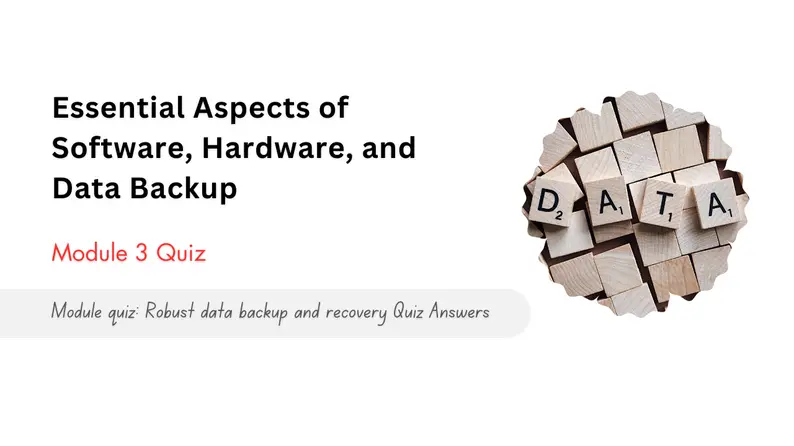Module quiz: Robust data backup and recovery Quiz Answers
In this blog post, I will be sharing the answers to the Module 3 Quiz titled “Module quiz: Robust data backup and recovery Quiz Answers” from the Coursera course “Essential Aspects of Software, Hardware, and Data Backup.”
Enroll Link: Essential Aspects of Software, Hardware, and Data Backup
Module quiz: Robust data backup and recovery Quiz Answers
Question 1)
Which principle outlines the recommended number of data copies, types of storage media, and storage locations to minimize data loss risks?
- The Golden Principle of Data Availability
- The Data Integrity Standard
- The 3-2-1 Backup Rule
- The Redundancy Maximization Method
Question 2)
Which of the following are key considerations when planning a data backup strategy? Select all that apply.
- Compliance requirements
- Data criticality
- Recovery Time Objective (RTO)
- The brand of storage devices
- Budget
Question 3)
An organization has faced multiple data loss incidents due to hardware failures and is looking to improve its data recovery strategy. Which actions would best enhance their data protection and recovery capabilities?
- Increase the frequency of full backups.
- Implement redundancy with RAID configurations and offsite backups.
- Limit data backups to critical data only.
- Exclusively use cloud storage for all backups.
Question 4)
Which image format is specifically designed for efficient compression while maintaining quality and supporting transparency?
- JPEG
- GIF
- PNG
- WebP
Question 5)
Which audio compression format is known for reducing file size without any loss of information, allowing for an exact reconstruction of the original sound?
- AAC
- FLAC
- MP3
- ADC
Question 6)
True or False: PDF documents can include features for accessibility, such as text-to-speech compatibility and navigation using assistive technologies, making them accessible to people with disabilities.
- True
- False
Question 7)
In the context of digital documentation and its widespread use in various sectors, which of the following features of the Portable Document Format (PDF) are highlighted for their critical role in document management, sharing, and long-term preservation? Select all that apply.
- Platform independence
- Automatic language translation
- Incorporation of multimedia elements
- Real-time collaboration tools
- Support for digital signatures
- PDF/A for long-term archiving
Question 8)
In the context of evolving digital storage needs and technologies, which of the following statements are accurate descriptions of the various data storage solutions available and their applications? Select all that apply.
- Cloud Storage provides scalable, remote storage solutions accessible from any internet-connected device, emphasizing convenience and flexibility with considerations for security and cost.
- Network-Attached Storage (NAS) devices are primarily used for their portability and ease of use in personal computing environments.
- Magnetic Tape offers a high-capacity, cost-effective solution for archival storage, favored for its reliability and low cost per gigabyte, despite slower access times.
- Hard Disk Drives (HDDs) utilize magnetic recording and are known for their cost-effectiveness for extensive storage needs, though they may have slower access speeds due to mechanical parts.
- Solid-State Drives (SSDs) eliminate moving parts by using flash memory chips, offering faster data access and improved durability but at a higher cost per gigabyte.
- Optical Discs are the leading choice for high-capacity enterprise data storage and backup solutions, due to their high speed and reliability.
Question 9)
True or False: The configuration and management of NAS units are predominantly done through physical interfaces on the device itself.
- True
- False
Question 10)
True or False: GPT is a newer standard than MBR and, supports disks larger than 2TB, and allows for virtually unlimited primary partitions.
- True
- False
Question 11)
True or False: For effective data backup, distinguishing between data storage and backups is unnecessary as they serve the same purpose.
- True
- False
Question 12)
Emil plans a backup strategy for his company’s rapidly growing client information database. He needs a backup method that minimizes downtime in case of data loss and ensures quick recovery. Considering these requirements, which backup method should he prioritize?
- Mirroring the database in real-time
- Utilizing cloud storage exclusively for all backups
- Incremental backups daily
- Regular full backups
Question 13)
An organization has faced multiple data loss incidents due to hardware failures and is looking to improve its data recovery strategy. Which actions would best enhance their data protection and recovery capabilities?
- Increase the frequency of full backups.
- Limit data backups to critical data only.
- Exclusively use cloud storage for all backups.
- Implement redundancy with RAID configurations and offsite backups.
Question 14)
True or False: Noise reduction techniques in audio processing can isolate and remove unwanted background noise without affecting the quality of the desired sound.
- True
- False
Question 15)
Which storage technology is known for eliminating moving parts, offering faster data access times, and improved durability compared to its predecessor?
- Solid-State Drives (SSDs)
- Hard Disk Drives (HDDs)
- Optical Discs
- Network-Attached Storage (NAS)
Question 16)
A small business plans to improve its data management and collaboration capabilities among employees working from various locations. Which NAS feature should be the primary focus to meet their needs?
- High-speed internet requirement for operation
- Low power consumption
- Media streaming capabilities
- Ease of access and sharing across a network
Question 17)
Which file system is recommended for Windows environments due to its support for large files and drives, file permissions for security, and shadow copies for backups?
- NTFS
- exFAT
- FAT32
- GPT
Question 17)
Marcia is working on a podcast series that will be distributed across various digital platforms. She wants to ensure her audio files are of high quality but also manageable in size for streaming and downloading. Which audio compression method should she use to balance sound quality with file size efficiency?
- AAC, for lossy compression with a balance of quality and file size
- FLAC, for lossless compression without any loss of sound information
- WAV, for uncompressed audio quality
- ALAC, for lossless compression tailored to Apple devices
Question 19)
Which PDF standard is specifically designed for the digital preservation of electronic documents, ensuring their future accessibility?
- PDF/A
- PDF Management Tools
- PDF/E
- PDF/X
Question 20)
Thandi has received a report from her colleague in a file format that her current software cannot open. What is her best course of action to access and work with the file?
- Use file conversion software or an online tool to convert the file into a compatible format.
- Delete the file, assuming it’s corrupted due to the inability to open it.
- Ignore the file and ask her colleague to summarize the report.
- JPEG with encryption
Question 21)
A large enterprise plans to overhaul its data storage infrastructure to improve data retrieval times and ensure high reliability for its critical operations. Which storage solution should they consider as a primary option?
- Hard Disk Drives (HDDs)
- Magnetic tape
- Solid-State Drives (SSDs)
- Optical discs
Question 22)
What feature distinguishes Network Attached Storage (NAS) systems from direct-attached storage (DAS)?
- They lack web-based management interfaces for configuration and administration.
- They function independently within a network environment and can serve multiple clients simultaneously.
- They have lower storage capacities.
- They require a direct connection to a computer.



